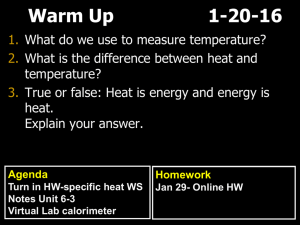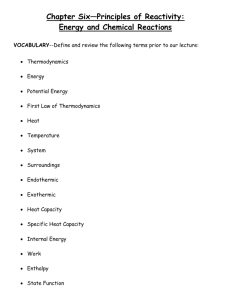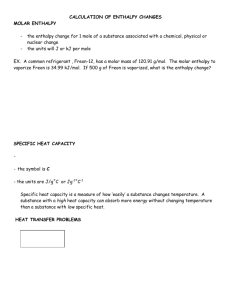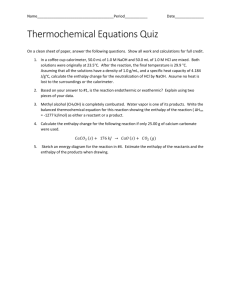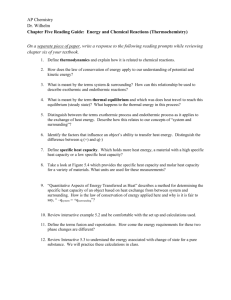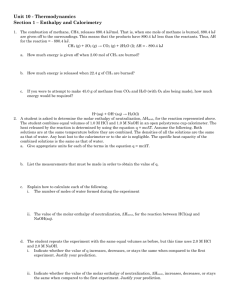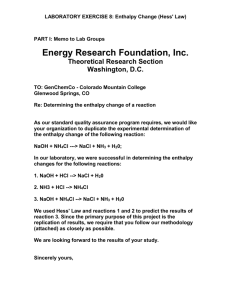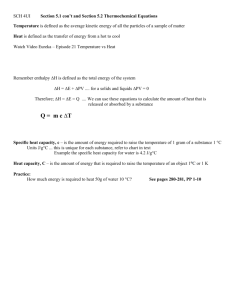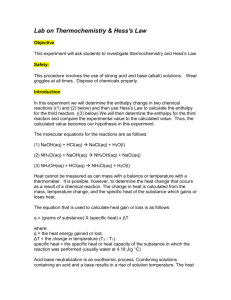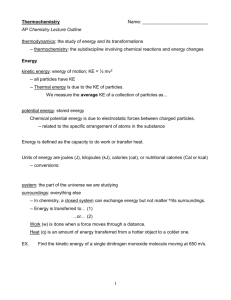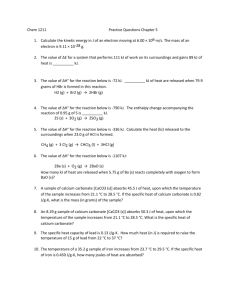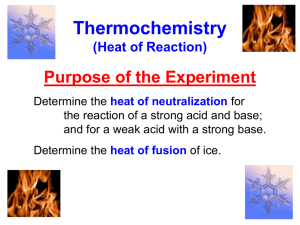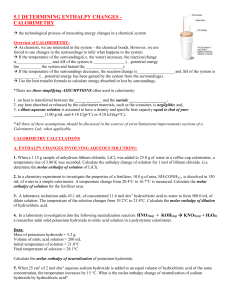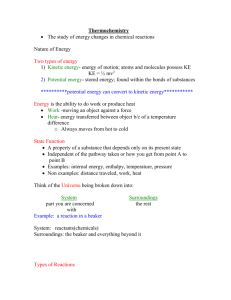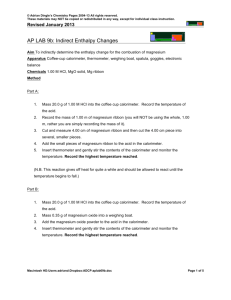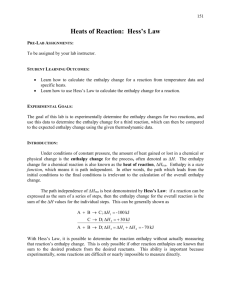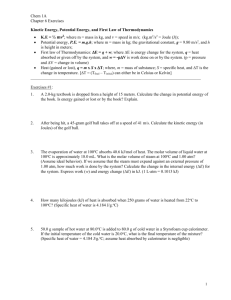Exam 2 Review Answers - Iowa State University
advertisement
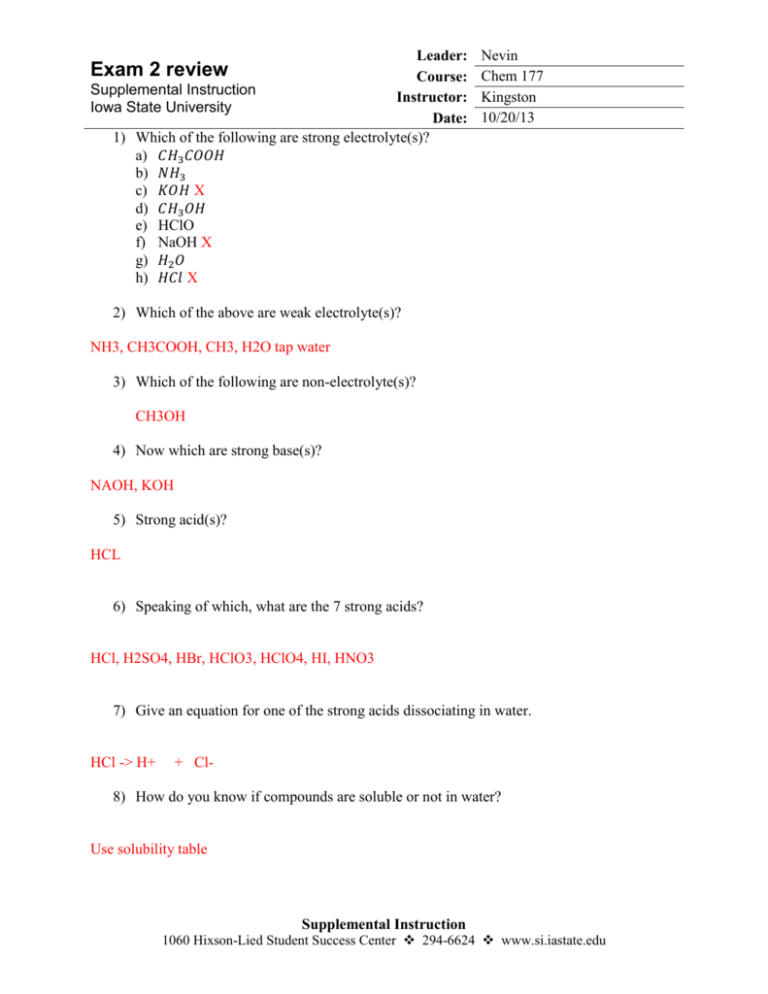
Leader: Course: Supplemental Instruction Instructor: Iowa State University Date: 1) Which of the following are strong electrolyte(s)? a) 𝐶𝐻3 𝐶𝑂𝑂𝐻 b) 𝑁𝐻3 c) 𝐾𝑂𝐻 X d) 𝐶𝐻3 𝑂𝐻 e) HClO f) NaOH X g) 𝐻2 𝑂 h) 𝐻𝐶𝑙 X Exam 2 review Nevin Chem 177 Kingston 10/20/13 2) Which of the above are weak electrolyte(s)? NH3, CH3COOH, CH3, H2O tap water 3) Which of the following are non-electrolyte(s)? CH3OH 4) Now which are strong base(s)? NAOH, KOH 5) Strong acid(s)? HCL 6) Speaking of which, what are the 7 strong acids? HCl, H2SO4, HBr, HClO3, HClO4, HI, HNO3 7) Give an equation for one of the strong acids dissociating in water. HCl -> H+ + Cl- 8) How do you know if compounds are soluble or not in water? Use solubility table Supplemental Instruction 1060 Hixson-Lied Student Success Center 294-6624 www.si.iastate.edu Write the complete ionic and net ionic equation for the following reaction. Label its spectator ions. 𝐶𝑜𝑝𝑝𝑒𝑟 (𝐼𝐼) 𝐻𝑦𝑑𝑟𝑜𝑥𝑖𝑑𝑒 𝑎𝑛𝑑 𝑃𝑒𝑟𝑐ℎ𝑙𝑜𝑟𝑖𝑐 𝐴𝑐𝑖𝑑 𝐶𝑎(𝑂𝐻)2 (𝑎𝑞) + 2 𝐻𝐶𝑙𝑂(𝑎𝑞) → 2𝐻2 𝑂(𝑙) + 𝐶𝑢(𝐶𝑙𝑂4 )2 (𝑎𝑞) 𝐻 + (𝑎𝑞) + 𝑂𝐻 − (𝑎𝑞) → 𝐻2 𝑂 (𝑙) The following is a redox reaction. Which element is oxidized? Which is reduced? What is the oxidizing agent? What is the reducing agent? 𝑃4 (𝑠) + 10 𝐻𝐶𝑙𝑂(𝑎𝑞) + 6𝐻2 𝑂(𝑙) → 4𝐻3 𝑃𝑂4 (𝑎𝑞) + 10𝐻𝐶𝑙(𝑎𝑞) Phosphorous is oxidized in P_4, P_4 is the reducing agent Chlorine is reduced in HClO, HClO is the oxidizing agent Suppose you mix 70 mL of .80M solution of Lead (II) Nitrate with 30 mL of .20 M Sodium Sulfide. Write the balanced equation. State the limiting reagent(s). How much precipitate forms? What is the molarity of the products? 𝑃𝑏(𝑁𝑂3 )2(𝑎𝑞) + 𝑁𝑎2 𝑆(𝑎𝑞) → 2𝑁𝑎𝑁𝑂3 (𝑎𝑞) + 𝑃𝑏𝑆(𝑠) Na_2 S is limiting reagent .006 mol of PbS * (molar mass of PbS) = grams of PbS (.012/.1L) = molarity of NaNO3 , since PbS is solid, it has no molarity Which compound has the highest concentration of Potassium? a)40 𝑚𝐿 𝑜𝑓 5𝑀 𝐾𝐶𝑙 𝑏)20 𝑚𝐿 𝑜𝑓 3𝑀 𝐾2 𝑆𝑂4 𝑐)80 𝑚𝐿 𝑜𝑓 2𝑀 𝐾𝑁𝑂3 𝑑) 25 𝑚𝐿 𝑜𝑓 2𝑀 𝐾3 𝑃𝑂4 How would you prepare 175.0 mL of .150 M AgNO3 with 1M AgNO3 (Change this from pure to 1 Molar) .02625 L of 1 molar AgNO3 How many grams of solute are in .250 L of .175 M KBr? 5.20g How many milliliters of .120 M HCl are needed to completely neutralize 50.0 mL of .101 M Ba(OH)_2 solution? 84.2 mL If 34 J of work is done on the system, but 50 J of heat is absorbed from the system, What is the change in internal energy ∆𝐸? Is this an endothermic or exothermic process? 16 J True or False: (apology for bad wording) Change in enthalpy for water from liquid to gas is positive. T Change in enthalpy from gas to liquid is endothermic. F If you reverse a reaction, the change in enthalpy stays the same (it is based off magnitude only) F In a bomb calorimeter, we need to take into account the mass of the substance. F If a piston is pushed down, work is done by the system. F If heat is given off by surroundings, the heat exchange with respect to system is exothermic. F Which of the following is NOT a state function? a) Volume b) Work c) Enthalpy d) Energy How do you find change in enthalpy In terms of change in energy, pressure, and change in volume? ∆𝐻 = ∆𝐸 + 𝑃∆𝑉 A coffee-cup calorimeter contains 150.0g of water at 25.1 degrees C. A 121.0g block of copper metal is heated to 100.4 degrees C. The specific heat of Cu is .385 J/g * K. The Cu is added to the calorimeter, and after a time the contents of the cup reach constant 30.1 degrees C. Determine the amount of heat, in J, lost by the copper block and the amount of heat gained by the water. Did any of the heat go else where? 3138 J gained by water -3275 J lost from copper 137 J gained by calorimeter A 1.800g sample of methane 𝐶𝐻4 is burned in a bomb calorimeter with a heat capacity of 5.63 kJ/℃. The temperature of the calorimeter plus contents increased from 23.36℃ to 26.37℃. Write a balanced chemical equation for the reaction. Heat of combustion Per Mole of phenol? 150.63 kJ/mol Calculate ΔH for the reaction 𝑁2 𝑂(𝑔) + 𝑁𝑂2 (𝑔) → 3𝑁𝑂(𝑔) Using the following data: 𝑁2 (𝑔) + 𝑂2 (𝑔) → 2𝑁𝑂(𝑔) ΔH = 180.7 kJ 2𝑁𝑂(𝑔) + 𝑂2 (𝑔) → 2𝑁𝑂2 (𝑔) ∆𝐻 = −113.1 𝑘𝐽 2𝑁2 𝑂(𝑔) → 2𝑁2 (𝑔) + 𝑂2 (𝑔) 𝛥𝐻 = −163.2 𝑘𝐽 How would you find the enthalpy of formation for 𝑁2 𝑂(𝑔) + 𝑁𝑂2 (𝑔) → 3𝑁𝑂(𝑔) assuming we didn’t use hess’ law but had the ΔH° of each of the reactants and products? Sum of Enthalpy of products – Sum of enthalpy of reactants Write the equation corresponding to the standard enthalpy of formation for CCl4(l) C(s) + 2Cl2 (g) -> CCl4(l) What is the relationship of frequency and wavelength? Inverse relation Which electromagnetic radiation is fastest? a) X-ray b) Radio frequency c) Beta rays d) None of the above (ALL electromagnetic radiation travels the speed of light!!!) An argon ion laser emits light at 789 nm. What is the frequency of the radiation? How much energy is emitted from 2 photons of this light. E = hv E = (h * c)/ (wavelength) E= 108 𝑚 ) 𝑠 6.626∗10−34 𝐽∗𝑠(3.0∗ 789∗10−9 𝑚 For 2 photons, multiply previous answer by 2. Which one-step transition of energy always absorbs the most energy a) n=2 to n=1 b) n=1 to n=2 c) n=100 to n=101 d) n=2 to n=3 Calculate the energy released or absorbed when an electron in hydrogen atom goes from n=2 to n=4. Is this energy absorbed or released? See resources (same list you probably found this) Describe Heisenberg’s Uncertainty principle. (Can be as simple as one sentence) You can’t know both the momentum and position of an electron at same time When the principle quantum number is 2, what are the possible 𝑚𝑙 𝑎𝑛𝑑 𝑙 quantum numbers? When n = 2, L = 0,1 , ml can equal -1,0,1 Which of the following is an impossible orbital orbital combination? 1p, 4s, 5f, 2d
